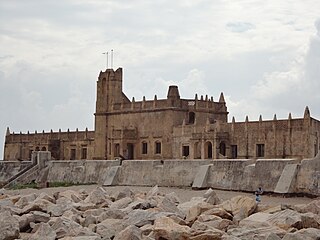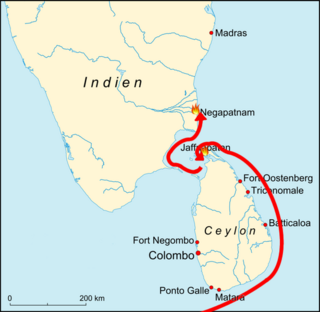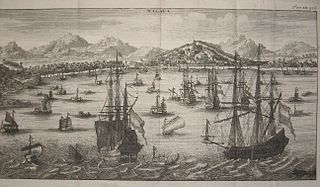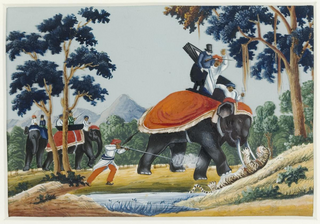
Danish India was the name given to the forts and factories of Denmark in the Indian subcontinent, forming part of the Danish overseas colonies. Denmark–Norway held colonial possessions in India for more than 200 years, including the town of Tharangambadi in present-day Tamil Nadu state, Serampore in present-day West Bengal, and the Nicobar Islands, currently part of India's union territory of the Andaman and Nicobar Islands. The Danish and Norwegian presence in India was of little significance to the major European powers as they presented neither a military nor a mercantile threat. Dano-Norwegian ventures in India, as elsewhere, were typically undercapitalized and never able to dominate or monopolize trade routes in the same way that British, French, and Portuguese ventures could.

The Skirmish at Pipli or more formally the Destruction of the Danish factory at Pipli, was one of the two recorded land confrontations between the Danish East India Company and the Mughal Empire during the Dano-Mughal War. The Skirmish was a Mughal punitive expidition in retalition for the Danish arrest of a Persian merchant. The Skirmish ended in a Mughal victory, and the Danish factory in Pipli was destroyed and burned down.

The Capture of The Bengali Prize, or the Seizure of The Bengali Prize, was a Danish capture and seizure of a larger Bengali vessel in late 1642 in the Bay of Bengal. The capture is known to be the first confrontation of the Dano-Mughal War, after the formal declaration of war.

The Siege of Dansborg alternatively the Siege of Fort Dansborg sometimes also referred to as Willem Leyel's siege of Dansborg, was a siege initiated by traveler and seafarer, Willem Leyel, against the men loyal to governor Bernt Pessart. The siege was concluded after the men at Dansborg opened the gates for Willem Leyel, surrendered, and accepted Leyel as the new governor.

Roland Crappé's raids on Portuguese colonies refers to a series of raids by Dutchman in Danish service, Roland Crappé, on Portuguese Ceylon and India. The raids were partially unsuccessful, in that Crappé's ship, Øresund, caught fire and sank.
Willem Leyel or Willum Leyel was a Danish governor of Tranquebar and captain in the Royal Dano-Norwegian Navy.

The Skirmish at the Strait of Malacca was a skirmish in 1644 between the claimed governor of Tranquebar, Bernt Pessart, and the local authorities of Dutch Malacca. The confrontation led to the imprisonment or death of all of Pessart's crew and the confiscation of the vessel, Dend gode Haab. Although Pessart and his crew would later be released and cooperate with the Dutch to spy on the Spanish in Manila.

The Ambush near the Bay of Manila, alternatively the Death of Bernt Pessart, was an ambush by the Indigenous peoples of the Philippines, against a combined Dano-Dutch espionaging expeditionary force in 1645. The ambush led to the death of former governor and president of Danish India, Bernt Pessart.

The Sieges of Tranquebar or the War between Tranquebar and Thanjavur refers to the warfare between the Thanjavur Nayak kingdom and Danish Tranquebar between 1655 – 1669. The Thanjavurian sieges were repelled, mainly due to the new fortifications being built around Tranquebar, and a peace agreement was issued in 1669.

The Conflict between William Leyel and Bernt Pessart refers to the tensions and minor civil war between Willem Leyel and Bernt Pessart over the governorship of Tranquebar and the Danish East India Company. The conflict led to the escape of Bernt Pessart, and the command at Tranquebar accepted Willem Leyel as governor of Danish India.

The Capture of St. Michael or the Seizure of St. Michael, was a Danish seizure of a Bengali ship in the Bay of Bengal. The Danes captured the Bengali ship and the vessel was subsequently incorporated into the Danish Navy given the name St. Michael.

The Battle of Balasore was an engagement between Bengali and English ships against Danish ships at Balasore. When the English failed to persuade the Danes, the Bengalis started attacking the English vessel, yet the English were rescued by the Dutch.
Roland Crappé or Roelant Crappé was a Dutch colonial official serving the Dutch and Danish East India Company. He became director general of the Ceylonese department of the Danish East India Company in 1618 and became commander in chief and governor of Tranquebar upon his seventh arrival in the Indies in 1624. During his leadership, new factories and offices were established and Danish trade went exceptionally well. He died in 1644 only a few years after his homecoming to Denmark.
Bernt Pessart, Berndt Pessart or Berent Pessart was a Dutch overhoved and self-proclaimed President of Danish India from 1636 to 1643. In his earlier years, he would serve the Dutch East India Company in Bantam, and in September 1636 he would land in Danish Tranquebar on the St. Jacob. Here he would serve the Danish East India Company until his deposure in 1643. His claim to being governor of Tranquebar, would lead to a confrontation known as the 1644 Skirmish at the Strait of Malacca with the local authorities of and end with the capture of Pessart and his crew. He again would serve the Dutch East India Company by espionage on the Spanish Philippines. He would die in June 1645 by an ambush of local natives near Manila.

The Expulsion of Danes from Balasore was a violent expulsion and ousting of the Danish East India Company from the Mughal habour and trading hub of Balasore in 1643 or 1644 by the local Mughal governor, Malik Beg.

The Sinking of the Flensborg, also known as the Sinking of the Flensburg, was a minor skirmish between Danish and Portuguese vessels in 1630 off the Portuguese-controlled Cape of Good Hope. The skirmish resulted in the sinking of the Danish man-of-war Flensborg and caused great financial concerns about the Danish project in India.

The Dano-Carical Conflict was a small-scale conflict between the Danes at Tranquebar and the Portuguese at Carical (Karaikal). The conflict includes three smaller naval engagements, which eventually led to a four-hour-long imprisonment of Danish Captain Simon Jansen.

Willem Leyel's war on Golconda, or simply the Dano-Golconda War, was a brief privateering war between Sultanate of Golkonda and the Danish East India Company led by Willem Leyel. The hostilities quickly resulted in a peace treaty and the two parties would soon reconcile.
Anders Nielsen was a Danish colonist and acting governor of Tranquebar from 1643 to 1648, in times when overhoved Willem Leyel was absent. During his service as acting governor of Tranquebar, Nielsen would defend the town from Thanjavurian General Tiagepule and support a mutiny against overhoved Leyel.

Ove Gjedde's Expedition or the Danish Expedition to India of 1618–1622 was the first Danish colonial expedition to the Indian subcontinent and Southeast Asia, reaching Ceylon, Thanjavur and Ayutthaya. The expedition was initiated by the newly established Danish East India Company and led by 24-year-old Ove Gjedde. Despite not achieving its original goal of monopolizing Ceylon, the expedition still managed to receive control and trading privileges over various coastal towns and cities.

















